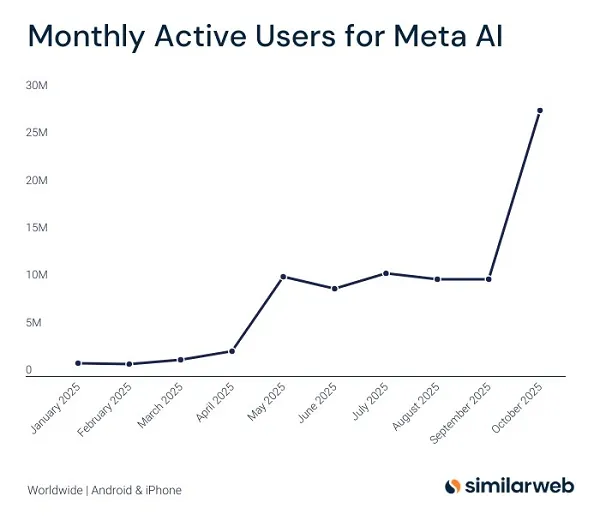Meta’s AI ‘Vibes’ Experiment Faces Trouble
 Adshine.pro11/19/202511 views
Adshine.pro11/19/202511 viewsDo people genuinely care about Meta’s expanding suite of AI tools—those image generators that place you in surreal settings, or video models that conjure scenes on command? Are these capabilities capturing meaningful public interest, or is Meta far more enthusiastic about them than its users?
That’s a difficult question to answer. Meta has repeatedly declared that its Meta AI chatbot is now the world’s most widely used AI assistant. Yet such a claim is inherently distorted by scale: Meta AI is woven into the search bar of every Meta-owned app.
With 3.54 billion people using Meta platforms daily, vast numbers end up interacting with Meta AI unintentionally. Usage, in this context, doesn’t necessarily reflect genuine demand for AI features.
A more revealing indicator is Meta’s standalone Meta AI app, which launched in April after the company renamed the “Meta View” app originally designed for the Ray-Ban smart glasses.
Even then, unless you owned the glasses, the app offered little beyond basic AI functions already available inside Meta’s social apps. Not surprisingly, the rebrand did not immediately shift usage patterns. But as this chart from Similarweb shows, interest spiked dramatically in recent months.

You can clearly see the increased momentum after April’s rebrand—and then a sharp surge more recently.
Some observers have pointed to this rise as evidence that Meta is “winning” the AI race. But even that narrative falls apart when you examine what triggered the spike.
The surge coincided with Meta’s introduction of the “Vibes” feed, an AI-generated video stream, rolled out at the end of September.

Interest in Vibes drove enormous curiosity. Similarweb reports that the Meta AI app was downloaded 8.8 million times in October alone. However, curiosity-driven spikes don’t reflect actual long-term engagement.
Which is why deeper usage data is more telling—and this week, Business Insider obtained internal Meta figures that shed light on what’s really happening.
According to BI:
- The Vibes feed has about 2 million daily active users, and engagement has slipped slightly week-over-week.
- - That’s notable when contrasted against the 30 million monthly active users in October. While comparing monthly and daily user data isn’t perfectly equivalent, the gap suggests that most people download the app, try it once, and don’t come back.
- - Most of early November’s growth came from India (702k daily users) and Brazil (114k daily users).
- - Europe, following the Vibes launch on November 6, contributed 23k daily users.
- - Usage is declining in parts of Southeast Asia, with the Philippines down 9% and Thailand down 7%.
Taken together, the numbers indicate mild interest—but not sustained engagement. A feed filled with endlessly generated AI clips seems unable to hold attention in a meaningful way.
And that’s hardly surprising, considering the sheer volume of low-quality content flooding that stream. But it also raises broader questions about Meta’s aggressive push into generative AI.
Meta appears determined to make AI unavoidable. The apps are now dotted with prompts encouraging users to try Meta AI—ask a question, summon a bot, tap into an AI-enhanced search. It’s everywhere.
But do people actually want this? Many of today’s AI outputs fall into what critics call “AI slop”—technically impressive but creatively hollow. It’s content in the most literal sense: stuff to scroll past, but seldom something that resonates.
Occasionally, you encounter AI-generated work that genuinely impresses, thanks to an original idea or a clever concept guiding it. But that reinforces the point: creativity depends on people, not algorithms. Social platforms are fundamentally about human insight, human humor, human voice.
And that’s precisely why AI replies feel sterile, and AI-written posts fall flat. Social media thrives on individuality. When you outsource your perspective to an AI model, you dilute the very thing that makes your contribution valuable.
The trend toward AI-generated filler content risks turning social networks into spaces where bots talk to bots—and humans observe a digital echo chamber mimicking conversation.
Is that really the future we’re building?
AI prompts can help organize thoughts or spark ideas, and there is value in that. But if you have nothing to say, why fill the space with algorithmic padding? Why crowd the feed with synthetic reflections that add little to the broader dialogue?
This is the uncomfortable truth: AI bots feel intrusive because they fill cultural silence that never needed filling. They generate content because they can—not because anyone needs or asks for it.
Some argue that AI features can spur conversation or inspire creativity. Occasionally that’s true. But the irreplaceable value in social media comes from perspective—the one thing AI cannot authentically replicate. Why smother that behind machine-generated varnish?
Meta is investing heavily in generative AI and positioning this wave of LLM-driven innovation as the road to future “superintelligence.” But even Yann LeCun, Meta’s own former AI chief, has argued that LLMs are a technological dead-end for achieving true intelligence—a recursive system stuck reshaping what already exists.
The path to artificial general intelligence won’t emerge from reprocessing old data. It will come from breakthroughs that allow machines to perceive, reason, and understand in ways that mirror the human mind.
LLMs, for all their utility, don’t do that. They operate on pattern prediction, not cognition.
And while that has meaningful applications, it remains unclear what value it adds to social platforms.
For now, the disconnect between Meta’s ambition and user appetite is increasingly visible. AI may be the future—but it’s not yet clear whether people want that future woven into every corner of their social experience.
📢 If you're interested in Facebook Ads Account, don't hesitate to connect with us!
🔹 https://linktr.ee/Adshinepro
💬 We're always ready to assist you!